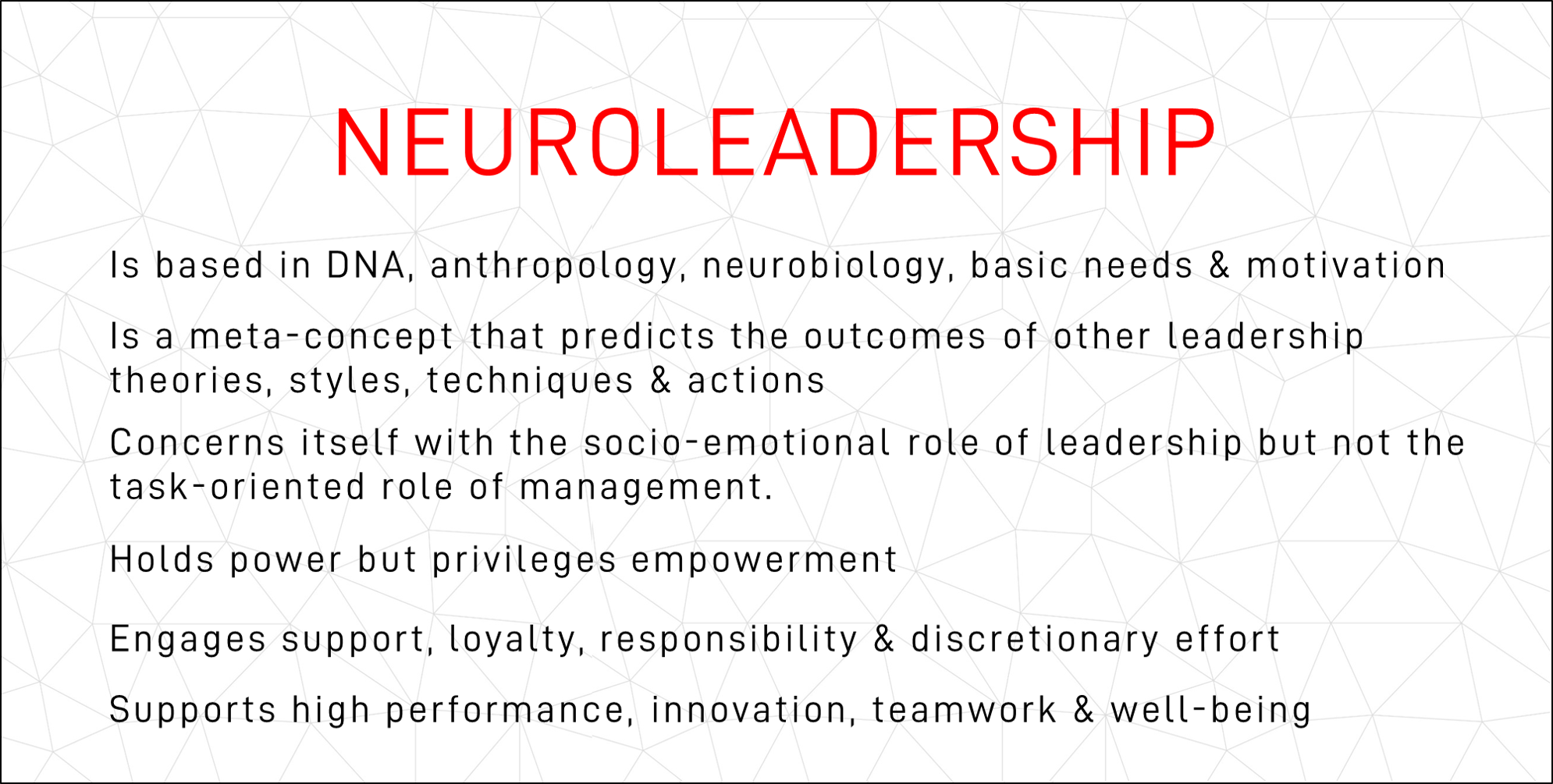Neuroleadership is an approach to leading self & others based in NEURO-M principles, social psychology & organisational behaviour. It is based in the primal, DNA and anthropological origins of leadership as an essential social role (as it is for any social species) and identifies the criteria by which leaders are identified. It describes attributes of leadership contenders that are most likely to resonate at an emotional/intuitive level, leading to rejection or support at a level below and much stronger than rationality. Indeed, rationality is filtered, interpreted & selectively drawn upon to support these primal decisions.
 Neuroleadership is not a prescriptive style or method. Neuroleadership is a meta-concept, describing the conditions under which leadership is supported, loyalty granted and sacrifices made, rather than promoting a single new or specific style of leadership instructions. It embraces some current leadership theories and styles, approves elements of others and largely rejects a few, typically old-school coercively-oriented views. Neuroleadership, as a social and neurobiological platform, is both guide and gatekeeper of what it is to be a leader, but not a designer of any one-size-fits-all technique.
Neuroleadership is not a prescriptive style or method. Neuroleadership is a meta-concept, describing the conditions under which leadership is supported, loyalty granted and sacrifices made, rather than promoting a single new or specific style of leadership instructions. It embraces some current leadership theories and styles, approves elements of others and largely rejects a few, typically old-school coercively-oriented views. Neuroleadership, as a social and neurobiological platform, is both guide and gatekeeper of what it is to be a leader, but not a designer of any one-size-fits-all technique.
There are many styles and ideas of leadership. Some have proven successful for some individuals, but that they aligned with the character and temperament of one or more leader in their culture, context and time is not in any way a reliable indicator that they will work for other people in other situations. Some are supported by science and evidence (for example, those who follow the principles of Self-Determination Theory are adhering to a generally well-founded and proven set of concepts), some go in and out of fashion (e.g., trait leadership and servant leadership), some work situationally (e.g., coercive and coaching styles) and some approaches vary in substance and sustainability (e.g. leadership as a performance versus leadership as character). Neuroleadership can be used to compare and predict the short and long term support, effectiveness and implications of any and all leadership styles, fashions and techniques with in the contexts they are attempted or applied.
As a socio-emotional rather than task-oriented role, Neuroleadership is not a style of management. It is aimed solely at the role of leadership as a social position, in or out of the workplace. Neuroleadership doesn’t concern itself with task delegation, KPIs or process compliance. Instead, and much more powerfully, neuroleadership engages hearts and minds so that others largely self-manage. Neuroleadership might be thought of as a macro-function, whereas management can be considered a micro-function.
This is not to say that neuroleadership and neuromanagement don’t cross paths at times, because they certainly do. In 1949 Henri Fayol described management as planning, leading, organising and controlling, and while the social contexts of today mean that his description may need some updating, or at least translating, the hierarchical power inherent in management requires a certain amount of leadership behaviour for subordinates to not only comply, but to allocate discretionary support and effort above and beyond core role requirements. Notably, leading is the only of the four elements identified by Fayol that inherently attends to the emotional and the interpersonal. This means, for example, that the practical foundation for Hersey and Blanchard’s popular “Situational Leadership” is a management technique, not an approach to, or style of, leadership. Similarly, Adair’s Action-Centred Model is oriented more toward task management (practical) than leadership (emotional). Instead of focusing on specific instructions and feedback, Neuroleadership is more concerned with guidance for effectively engaging support, effort and loyalty while promoting self-regulation and self-management.
Neuroleadership, in a modern western workplace context, is more about connecting, inspiring and empowering than directing and controlling, privileging empowerment over power. While this is consistent with current popular cultural sentiments and values, it is also neurally consistent. Neuroleadership is inherently compatible with basic neurobiological functions, health and response systems, even when things are toughest. Crucially, and alone in this approach, Neuroleadership is naturally appealing to core intrinsic (and largely nonconscious) motivations and neural consistency. (These are described in more detail as NEURO-M Concepts in various training modules).
Through appealing to intrinsic fulfilment, especially through connection, safety and empowerment, within a purposeful social system, Neuroleadership naturally engages hearts, minds and muscle. As higher support, discretionary effort and responsibility are linked to higher fulfilment, it is natural that individuals will want to take on more challenges & be willing to hold themselves, and be held by others, accountable for their accomplishments – simply because they feel intrinsically rewarded for doing so. In turn, and as a result of the neurobiological responses and mechanisms involved, Neuroleadership sustainably enhances quality, innovation, productivity, cooperation and personal well-being.
Neuroleadership is the standard by which other ideas, and any technique, of leadership can be reliably measured, and effectiveness, sustainability, outcomes and well-being predicted. Neuroleadership Training is exclusive to 21 Triangles and available on request.